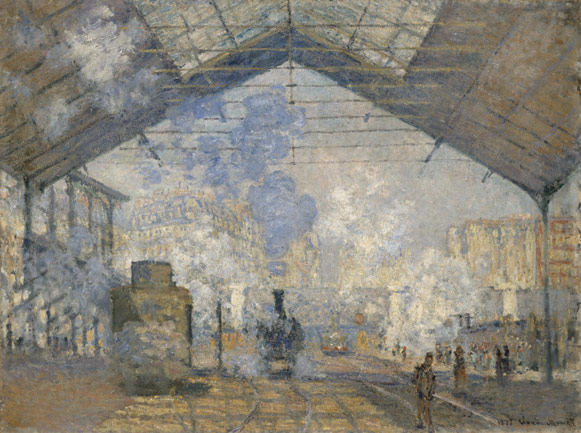Fr : version française / En: english version

Commuting
The modernization of public transit systems has brought places closer together: France's first train line, Paris to Saint-Germain-en-Laye, was opened in 1837. Now it is an unremarkable suburban rail link. It is no longer unusual for certain "suburbanites" to travel more than 100 km daily to get to work thanks to fast rail links. Whereas public transit systems have already redefined our cities, now they are reshaping much wider areas.
La gare Saint-Lazare
In 1877, a year after the first Impressionist exhibition, Monet abandoned his country scenes in favor of the urban landscape. He left Argenteuil and settled in the Nouvelle Athènes district of Paris. He was granted permission to set up his easel in the nearby Saint-Lazare station. The modern feel of the place as much as the shifting light effects in the main shed served as inspiration for a series of paintings, including this one, purchased shortly afterwards by his contemporary Gustave Caillebotte.
Claude Monet
Claude Monet was born in Paris on November 14, 1840, but stayed only five years in the French capital. His parents moved to Le Havre in 1845, where they sold colonial wares. As a teenager, Monet showed his caricatures in local art shops, which led to a meeting with Eugène Boudin, with whom he began painting landscapes. Monet refused to attend Le Havre school of fine arts and set off to study at the Académie Suisse in Paris, where he met Pissarro and Cézanne. Returning to Le Havre after completing his national service, he completed his studies with Boudin and the Dutch artist Jongkind, before returning to the capital and the studio of Charles Gleyre, where he met Sisley, Bazille and Renoir.
In the 1860s, Monet and his friends often met Manet and Zola at Café Guerbois, had their work refused at every Salon, sought new inspiration around Paris and subsisted in extreme poverty. In 1869, Monet and Renoir did the first paintings in Bougival, featuring the visible brush strokes that prefigured impressionism. The following year, Monet married Camille, his model, with whom he already had a son, Jean, born in 1867. In 1874, weary of official rebuttals, the young painters organized their own exhibition in the studio of the photographer Nadar, where Monet exhibited Impression, Sunrise, the picture that spawned the satirical criticism that inadvertently gave the movement its name.
The 1870s were much like the previous decade: Monet produced wonderful paintings yet continued to exist on the poverty line. He was now living outside Paris (in Argenteuil and Vetheuil), where life was more affordable. He traveled to London in search of Turner, where he met Whistler, whom he befriended. Camille died in 1979 and Monet moved to Poissy, then to Giverny in 1883, where he lived until his death on December 5, 1926. He began to taste success in Giverny in the late 1880s (largely thanks to his friend the writer and critic Octave Mirbeau), bought the property in 1890, remarried a woman named Alice in 1892, and began to cultivate his garden, with its large willow trees and pond covered in water lilies, which he continued to paint until his final days.










